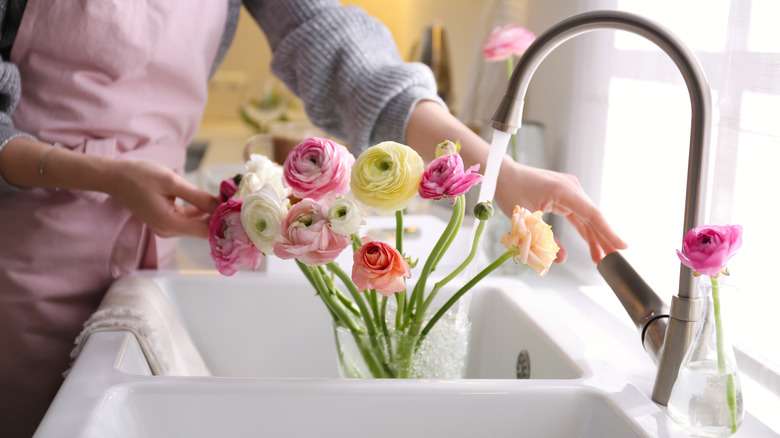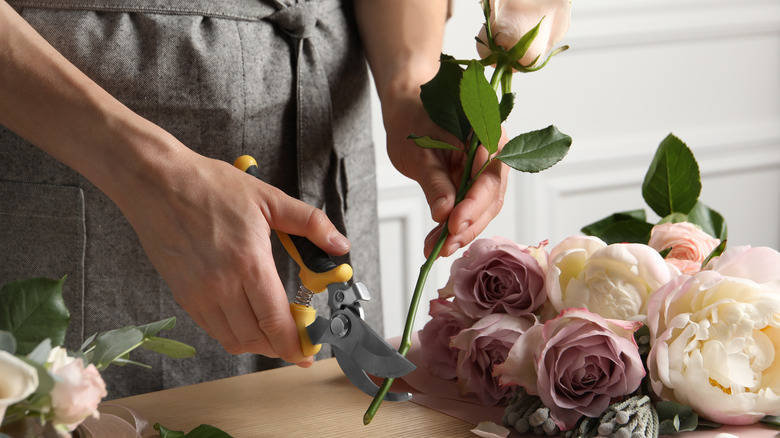Apple Cider Vinegar Is A Must-Have If You Love Fresh-Cut Flowers
Do you remember the first time you received fresh-cut flowers from the love of your life? You wished the vibrant blooms would last forever. If only you could shellac the blossoms while they were in their prime so you could enjoy their color and fragrance every day. Sadly, garden-fresh bouquets have a limited lifespan; eventually, they wilt and die. However, your dream of extending their natural beauty for as long as possible doesn't have to if you feed your fresh floral arrangement a little apple cider vinegar. As unlikely as it may seem, the sour liquid contains antibacterial properties that can help to decelerate the demise of fresh-cut blooms.
If you believe the hype, apple cider vinegar is the best thing since sliced bread. Its superpowers span the spectrum from getting rid of pet odors in your home to purportedly helping lower cholesterol and blood sugar levels in your body. And you thought the pantry staple peaked as a pickling ingredient. Turns out the tangy condiment, which is made via fermentation by combining crushed apples, sugar, and yeast, can be a flower's best friend thanks to its composition as an acetic acid. Fresh blooms arranged in a water-filled vase are subject to natural decomposition. This process can foster an environment ripe for bacteria and fungi to permeate and clog flower stems, causing them to die faster. However, the acidity in apple cider vinegar acts as a natural disinfectant, killing harmful germs so blossoms stay fresh longer.
How to make an apple cider vinegar solution for flowers
Whether you're trying to increase the lifespan of bulk flowers from Costco, a rustic bouquet from your own garden, or an upscale arrangement from a trendy florist, the key is to protect the water your blooms are drinking. On average, fresh-cut flowers will remain vibrant for about a week; however, you can stretch that sparkle for another week or so by feeding them a life-enhancing DIY solution that combines water, apple cider vinegar, and sugar.
Start by filling a medium-sized vase with clean water. Next, add in 2 tablespoons of apple cider vinegar and 2 tablespoons of white granulated sugar. Mix thoroughly and then add in the flowers. The apple cider vinegar will help reduce bacteria from infiltrating the water while the sugar acts as a preservative and provides essential nutrients to help sustain the life of your floral arrangement. Just remember to change out the water and mix up a new solution every few days to keep your flowers fresher longer.
If you don't have apple cider vinegar on hand, you can substitute it with white vinegar or lemon or lime juice. The idea is to include an acid component that will hinder bacteria growth in the vase water. Damaging microorganisms that proliferate in standing water can choke the blooms' stems and block buds from absorbing the nutrients they need to survive.
Tips to keep fresh-cut flowers alive longer
Another way you can prolong the life of fresh-cut flowers is to carefully trim their stems in a way that exposes more surface area and allows them to efficiently absorb the apple cider vinegar mixture. Simply use a sharp pair of scissors or garden shears to make a 45-degree angle cut at least an inch from the bottom of the flower's stem. After making the slanted slice be sure to remove any leaves that may be sitting below the vase's water line. Eliminating these leaves will reduce bacterial growth. It's a good idea to complete this task each time you change the flowers' water — roughly every two to three days. Don't wait until the vase water becomes discolored or cloudy before pruning and adding fresh water.
In addition, when swapping the old water for new, take a few extra minutes to clean the vase. Giving your flowers' vessel a good scrub can get rid of any existing mold or slimy areas that harbor bacteria. It's also important to assess the vase's size before adding more flowers to the original arrangement. Overcrowding a container will hasten a bouquet's demise. If you don't have a vase large enough to allow blooms to breathe properly, divide them into multiple smaller vases or mason jars. This extra space will allow air to circulate freely and reduce the amount of bacteria-laden debris that may congest your fresh-cut flowers' home.


